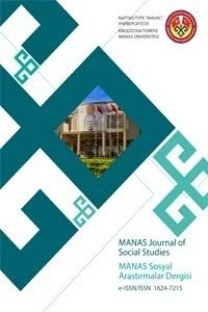“OTHERIZATION” IN HANIF KUREISHI’S THE BUDDHA OF SUBURBIA
HANIF KUREISHI’NİN VAROŞLARIN BUDA’SI ADLI ESERİNDE
___
Ambursley, U. (2006). The search for identity in anita and me and the buddha of suburbia. Extended Essays. Unpublished Dissertation.Bhabha, H. (1983). The other question…. Screen, 24(6), 18-36
Blumer, H. (1958). Race prejudice as a sense of group position. The Pacific Sociological Review, 1(1), 3-7. doi:10.2307/1388607.
Buchowski, M. (2006). The specter of orientalism in Europe: From exotic other to stigmatized brother. Anthropological Quarterly, 79(3), 463-482.
Cornea, C. (2010). Stereotypes in Hanif Kureishi‟s The Buddha of Suburbia. Criterion, 1(3), 1-10.
Fanon, F. (1952). Black skin, white masks. London: Get Political.
Fassin, D. (2001). The biopolitics of otherness: Undocumented foreigners and racial discrimination in French public debate. Anthropology Today, 17(1), 3-7.
Felsenstein, F. (1995). Anti-semitic stereotypes: A paradigm of otherness in English popular culture. USA: John Hopkins University Press.
Hashmi, A. (1992). Hanif Kureishi and the tradition of the novel. The International Fiction Review, 19(2), 88-95.
Kivel, P. (2006). Uprooting racism: How white people can work for racial justice. Canad: New Society Publishers.
Kumaravadivelu, B. (2008). Cultural globalization and language education. USA: Yale UP.
Kureishi, H. (1986). The rainbow sign. My Beautiful Laundrette. London: Faber and Faber.
Kureishi, H. (1990). The Buddha of Suburbia. London: Faber and Faber.
Nelson, T. (2014). Critical topics in family therapy: AFTA monograph series highlights. New Jersey: Springer Cham.
Okuroglu Ozun, S. (2017). Disrupted Borders in The Buddha of Suburbia. B/orders Unbound: Marginality, Ethnicity and Identity in Literatures. Germany: Peterlang.
Onmus, S. (2012). Hybrid identities in the Buddha of suburbia by Hanif Kureishi and The Namesake by Jhumpa Lahiri (Unpublished Thesis). Ankara.
Persson, S. (2010). The individual and the collective: A discussion of identity and individualism. Global, 4(5). https://www.21global.ucsb.edu/global-e/december-2010/individual-and-collective-discussion-identity-and%C2%A0individualism.
Pyke, K. D. (2010). What is internalized racial oppression and why don't we study it? Acknowledging racism's hidden injuries. Sociological Perspectives, 53(4), 551-572.
Phelan, J. (1999). The lessons of „weymouth‟: Homodiegesis, unreliability, ethics, and the remains of the day. Narratologies: New Perspectives on Narrative Analysis. Columbus: Ohio State UP.
Powell, J. & Menendian, S. (2016). The problem of othering: Towards inclusiveness and belonging. Othering & Belonging: Expanding the Circle of Human Concern, 1, 14-40.
Pyke, K. D. (2010). What is internalized racial oppression and why don't we study it? Acknowledging racism's hidden injuries. Sociological Perspectives, 53(4), 551-572.
Said, E. W. (1978). Orientalism. New York: Penguin.
Yang, G. et al. (2006). The essence, characteristics and limitation of post-colonialism: from Karl Marx's point of view. Frontiers of Philosophy in China, 1(2), 279-294.
Yu-cheng, L. (1996). Expropriating the authentic: The cultural politics in hanif kureishi‟s the Buddha of suburbia. Euramerica, 26(3), 1-19.
- ISSN: 1694-7215
- Yayın Aralığı: 4
- Başlangıç: 2001
- Yayıncı: KIRGIZİSTAN-TÜRKİYE MANAS ÜNİVERSİTESİ
KIRGIZ VE TÜRKİYE TÜRKÇESİ DEYİMLERİNDE “KALP/ YÜREK”
TÜRKİYE İLE KAZAKİSTAN ARASINDAKİ TİCARİ İLİŞKİLERE YÖNELİK ENGELLER
Erdoğan KAYGIN, Ethem TOPÇUOĞLU, Serdal ÖZKES
KOBİ YÖNETİCİLERİNİN STRATEJİK BİLİNÇ VE STRATEJİK YÖNETİM ALGILARI ÜZERİNE BİR İÇERİK ANALİZİ
İŞKOLİKLİK VE BİREYSEL MUTLULUK ARASINDAKİ İLİŞKİNİN TURİZM AKADEMİSYENLERİ AÇISINDAN İNCELENMESİ
Özge GÜDÜ DEMİRBULAT, Gencay SAATÇİ, Cevdet AVCIKURT
TÜRKİYE EKONOMİSİNDE DIŞ BORÇ, EKONOMİK BÜYÜME VE CARİ İŞLEMLER DENGESİ İLİŞKİSİNİN ANALİZİ
ULUSLARARASI ALANDA OMBUDSMANLIK KURUMU VE TÜRKİYE
OKULLARDA ÖRGÜTSEL DERTLEŞMEYE ŞLŞŞKŞN ÖĞRETMEN GÖRÜŞLERİ
Canan DEMİR YILDIZ, Burhanettin DÖNMEZ
ORTAÇAĞ’DA ŞAM DİYARININ STRATEJİK BİR KALESİ: ACLÛN KALESİ
TÜRKİYE’NİN ŞANGHAY İŞBİRLİĞİ ÖRGÜTÜ’NE OLASI ÜYELİĞİNİN AVRASYA POLİTİKASINA ETKİLERİ
